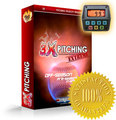 Checkout my article in the College World Series 2013 Edition for Baseball America. Post your comments below!
Checkout my article in the College World Series 2013 Edition for Baseball America. Post your comments below!
So you are looking for the top ten pitching velocity drills to add 5-10mph to your fastball? I get dozens of calls a week from pitchers, coaches and parents who are desperate to increase pitching velocity. You cannot deny the power of this highly sought after commodity. It is like a drug and the problem is most young pitchers think they have to do drugs to get more of it.
There is a better way. It is better because this road doesn’t come with the risk of getting caught and the side effects of drug abuse. This way is researched and proven significantly effective in increasing pitching velocity. The only challenge is putting in the work necessary to develop the high velocity pitcher.
The Conventional Wisdom of Pitching is the Problem
“Lift up, down and out.” “Slow controlled stride.” “Land soft.” “Lift and fall into front foot strike.” ”Shorten your stride.” “Stay back, reach out.” “Land closed and then rotate your hips.” “Don’t push off.” “Slow down.” We have all heard these coaching tips and the majority of pitching instruction out there is echoing this conventional wisdom everyday in this game.
This conventional wisdom is way behind the times and these conventional pitching coaches are coaching pitchers with the same information that was being taught even before the computer existed. The digital age has completely changed the understanding of the high velocity pitcher because of high speed cameras, motion capture and video analysis. If a pitching instructor has not studied pitching outside of playing this game then there is a good chance that they are coaching this skill with the same conventional wisdom that they were taught when they were young pitchers. This is why young pitchers turn to illegal drugs for the edge when all they need is someone to give them the latest science that is changing this game and a program to keep them focused on the goal.
The Proven Approach to Increase Pitching Velocity
Studies show high velocity pitchers generate more ground reaction forces than low velocity pitchers (1,2) and also transfer these forces more efficiently into the hip and trunk before pitch release (3). Studies also show that the high velocity to low velocity pitcher are more different early in the pitching delivery and more the same at the end (4). Here is an excerpt from a case study proving how important the lower power energy is to becoming not only a high velocity pitcher, but a healthy one.
Kibler and Chandler calculated that a 20% decrease in kinetic energy delivered from the hip and trunk to the arm requires a 34% increase in the rotational velocity of the shoulder to impart the same amount of force to the hand.
This is powerful proof that the more effective approach to increasing pitching velocity is through the power production and motor coordination of the lower half. The list of drills in this article are ideal for programing these proven high velocity movements. What these drills do not do is develop the power production necessary to move through them in an explosive manner. This is where a power focused strength and conditioning program, for the full range of motion pitcher, is needed. These drills are from the 3X Pitching Velocity Program, which also includes the critical strength and conditioning program to develop the power pitcher.
Studies Prove Strength Training Increases Pitching Velocity
“Pitchers aren’t athletes.” “Pitchers are freaks.” “Lifting weights make you tight and slow.” “Lifting weights will injure you.” “Lifting weights doesn’t work.” More conventional wisdom that old school pitching coaches continue to preach in hopes to scare their young pitchers away from this approach to training the athlete because they have little knowledge of the practice.
If you come from this school of thought that strength and conditioning programs do not increase pitching velocity then here is a short list of 6 case studies that prove the correlation between strength training and increasing pitching velocity.
- Escamilla RF, Ionno M, deMahy MS, Fleisig GS, Wilk KE, Yamashiro K, Mikla T, Paulos L, Andrews JR. – Comparison of three baseball-specific 6-week training programs on throwing velocity in high school baseball players. – Department of Physical Therapy, California State University, Sacramento, California, USA. – J Strength Cond Res. 2012 Jul;26(7):1767-81.
- Lehman G, Drinkwater EJ, Behm DG. – Correlation of throwing velocity to the results of lower-body field tests in male college baseball players. – School of Human Kinetics and Recreation, Memorial University of Newfoundland, St. John’s, Newfoundland, Canada School of Human Movement Studies, Charles Sturt University, Bathurst, New South Wales, Australia. – J Strength Cond Res. 2013 Apr;27(4):902-8.
- Wooden MJ, Greenfield B, Johanson M, Litzelman L, Mundrane M, Donatelli RA. – Effects of strength training on throwing velocity and shoulder muscle performance in teenage baseball players. – J Orthop Sports Phys Ther. 1992;15(5):223-8.
- Escamilla RF, Fleisig GS, Yamashiro K, Mikla T, Dunning R, Paulos L, Andrews JR. – Effects of a 4-week youth baseball conditioning program on throwing velocity. – Andrews-Paulos Research and Education Institute, Gulf Breeze, Florida, USA. – J Strength Cond Res. 2010 Dec;24(12):3247-54.
- Werner SL, Suri M, Guido JA Jr, Meister K, Jones DG. – Relationships between ball velocity and throwing mechanics in collegiate baseball pitchers. – Texas Metroplex Institute for Sports Performance, Grand Prairie, TX 75050, USA. – J Shoulder Elbow Surg. 2008 Nov-Dec;17(6):905-8.
- Carter AB, Kaminski TW, Douex AT Jr, Knight CA, Richards JG. - Effects of high volume upper extremity plyometric training on throwing velocity and functional strength ratios of the shoulder rotators in collegiate baseball players. – Department of Health, Nutrition, & Exercise Sciences, University of Delaware, Newark 19716, USA. – J Strength Cond Res. 2007 Feb;21(1):208-15.
I Went From Low 80’s to Low 90’s Post Surgery
I am not your major league pitcher, but what I did do well in my career was completely destroy my rotator cuff to the point I couldn’t even use my arm to brush my teeth. It happened in the forth inning of my first freshman appearance in junior college baseball. The worst part was after the surgery. The doctors told me I didn’t have it in me to overcome this injury and that I was wasting my time trying to recover and play again. Up to this point I had done everything conventional wisdom had told me to do and all it gave me was a 4 inning college career.
This was the best thing that ever happened to me because I decided to think for myself and develop a program that would not only get me back to playing again, but to help me reach my goals of 94mph and a chance to play some pro ball. Everything listed below and so much more is what I learned and put into a revolutionary pitching velocity program called 3X Pitching.
Top 10 3X Pitching Velocity Drills to Add 5-10mph
The drills listed below are from the 3X Pitching Velocity Program. The terminology below may be foreign to you because it comes from the research that makes up the 3X Pitching Velocity Program. I would highly recommend that you visit www.TopVelocity.net to learn more about this research and approach so you have a better understanding of what these drills will do for your pitching velocity. If you have any questions on the drills below or would like more information please contact me 985.878.5103.
- 3X Med Ball Chest Up Series - This series of throws use a 2lb medicine ball to teach the pitcher how to generate ground reaction forces through the stride and transfer these forces into the trunk movements to fire the arms and generate velocity. In the chest up position this prevents the pitcher from only using the shoulders and arms to generate the velocity.
- 3X Med Ball Separation Series - This series is also with the 2lb medicine ball and converts the transfer of forces from the stride into trunk rotation or hip to shoulder separation. Studies link more hip to shoulder separation to increased pitching velocity (4).
- 3X Med Ball Lateral Series - This series is similar to the previous two but are performed in a lateral foot position as opposed to the linear foot position of the previous drills.
- 3X Chest Up Target Throws Series - This series of throws replaces the med balls with the baseball. The goal is to keep the same motor coordination of the movements performed with the med ball when throwing the baseballs.
- 3X Separation Target Throws Series - This series of throws is similar to the previous ones but converts the stride power into hip to shoulder separation.
- The 3X Sled - This drill uses a sled to apply resistance to the hips which forces the pitcher to initially align the force vector into a linear position, while building flexion to then have the ability to drive the sled through the stride. This drill along with the next one is so effective when training a more explosive stride that converts into hip and trunk rotation.
- 3X Assistance Drills - This drill will prove the physics of 3X Pitching and its effect on increasing pitching velocity. As the pitcher moves through the drill, assistance is applied to the back hip to increase ground reaction forces at front foot strike. If the pitcher can effectively and efficiently convert this into more hip to shoulder separation the pitcher throws harder.
- 3X Drive Drills - These high intensity drills force the pitcher to enhance explosive stride power while increasing stride distance.
- Force Vector Throws (Level 3) - This is another series of more advanced 3X Pitching drills that mainly focus on the load position. It helps the pitcher build the muscle memory around the load position.
- 3X Power Throws - This is the 3X Pitching alternative to long toss. The challenge of long tossing is keeping the same mechanics that the high velocity pitcher uses when on the mound. These throws prevent you from changing these 3X pitching mechanics when increasing your distances.
The Top Pitching Velocity Program to Add 5-10+mph
 This program has helped tons of pitchers live the dream of throwing 90+mph and signing with a D1 University, getting drafted by a Major League Organization and making it back to Major League Baseball. Many scouts in all organizations of baseball have recommended this program to help young pitchers get to the 90+mph range to improve their value at the next level.
This program has helped tons of pitchers live the dream of throwing 90+mph and signing with a D1 University, getting drafted by a Major League Organization and making it back to Major League Baseball. Many scouts in all organizations of baseball have recommended this program to help young pitchers get to the 90+mph range to improve their value at the next level.
The reason the 3X Extreme Pitching Velocity Program works is because it is based off of science and it has been proven to add 5-10+mph to your fastball on thousands of pitchers. It isn't rocket science or voodoo, it is the real deal! The program comes with a high level workload of drills, lifts and exercises scientifically programmed to enhance throwing speed on the mound while developing an efficient pitching delivery. The format of the 3X Pitching Velocity Program is similar to the same approach Olympic throwers have been using for decades to increase throwing velocity. This approach isn't new to the sports world but it is new to baseball.
If you are serious about your career and are insanely driven to put yourself into an extremely small percentage of pitchers who are potential D1 prospects, top level draft picks or you just want to reach your potential on the mound then this program is the best chance you have to making your dreams come true.
Learn more about the 3X Extreme Pitching Velocity Program or get started TODAY adding 5-10+mph!
Reference
- MacWilliams BA, Choi T, Perezous MK, et al. - Characteristic Ground-Reaction Forces in Baseball Pitching. - Am J Sports Med. 1998;26(1): 66-71.
- Chun-Lung Lin, Chung-Yu Chen, Hong-Wen Wu, Chen-Fu Huang. - Characteristic Ground-reaction Force In Beginner Baseball Pitching. - Department of Physical Education, National Taiwan Normal University, Taipei, Taiwan, Graduate School of Physical Education, National Taiwan College of P.E., Taichung, Taiwan, Department of Sports Medicine, China Medical University, Taichung, Taiwan.
- Kibler WB, Chandler J. Baseball and tennis. In: Griffin LY, editor. , ed. Rehabilitation of the Injured Knee. St. Louis, MO: Mosby; 1995:219-226.
- Glenn S. Fleisig, James R. Andrews, et al. - Comparison Of High Velocity And Low Velocity Pitch Deliveries. - American Sports Medicine Institute 2007.


My name is Robinson Smith i’m 15 years old currently throwing 84+mph hoping the best from this program if all goes well going to suggest to friends
Sounds great Robinson, let us know if we can help you get settled into the program. Let’s work together to make you the next 90+ mph Testimonial.